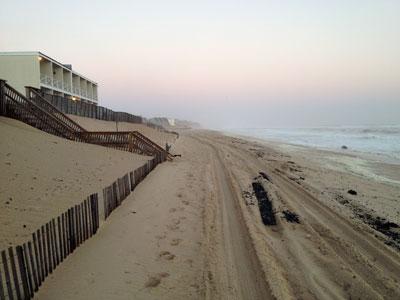State Sanguine on Sandbag Plan

As December arrives and construction by the Army Corps of Engineers of a reinforced sand dune to stabilize the downtown Montauk beach comes closer, the East Hampton Town Board has granted the state’s Department of Environmental Conservation “lead agency” status for environmental review of the project even though questions are still being raised about potential damage to the beach. The state issued an initial finding this week that no further review would be required, but is accepting public comment.
According to a timeline designed for completion of the $8.9 million project before the summer season, the federal agency is to begin seeking bids before the end of the year on the approximately 16-foot sand dune along 3,100 feet of beach, which will be reinforced with 14,000 sand-filled geotextile bags. Designated an emergency measure following Hurricane Sandy, it would be paid for entirely by the Army Corps.
The town board unanimously approved three resolutions at its meeting last Thursday that moved the project forward even though Carl Irace, an attorney with Bainton Lynch of East Hampton, which represents the Eastern Long Island Chapter of the Surfrider Foundation, and Jeremy Samuelson, executive director of Concerned Citizens of Montauk, raised questions about doing so.
Mr. Irace said that based on opinions of coastal experts, the Surfrider Foundation believes the project “is going to destroy our beach.” The organization and its members have repeatedly asserted that the planned reinforced dune would have the same effect as a hard structure, such as a rock wall, and accelerate erosion.
“I don’t believe that the net result is negative,” Town Supervisor Larry Cantwell said when asked about these comments on Tuesday. “I don’t believe that the geotextile sand-filled tubes are a permanent structure that’s going to harm the beach.” He added that he “would feel differently” if a permanent rock structure were proposed.
As the Army Corps envisions a more extensive and long-awaited beach reconstruction project as part of what is called the Fire Island to Montauk Point reformulation study, the geotextile-reinforced sand dune is “nothing more than a short-term-to-interim measure,” Mr. Cantwell said.
Speaking at last Thursday’s meeting, Mr. Samuelson reiterated a recommendation his group had made last year, that the town hire an independent coastal engineering firm to provide insight and represent the town’s interests throughout the process.
“We have very little input into the engineering of the project,” Supervisor Cantwell said Tuesday. “It’s pretty much being dictated by the Army Corps.”
“I think the town has a responsibility . . . to ensure that we’ve done due diligence,” Mr. Samuelson said, “and not just take the D.E.C.’s and the Army Corps’ word for it.”
Mr. Cantwell said Mr. Samuelson’s point was well taken. However, although he said that he “would be more comfortable” having such an adviser, he said that given the project’s timeline it may not be a realistic goal.
“We’re at the 12th hour here; the goal is to try to get this project done between now and April,” he said.
Mr. Cantwell noted that Kim Shaw, the town’s natural resources director, had sought opinions from several experts who volunteered their services throughout the process. Nonetheless, he said, an independent engineer might be advisable to provide oversight for the town during the construction.
The supervisor said that long-term planning for all of the town’s coastal shores was the highest priority. “I’m doing all I can to get grant money to look at all our coastal issues townwide,” he said, “so we can plan how to rebuild, in advance of an emergency.”
“We have to anticipate damage,” he said, and make decisions based on the specifics of particular areas as to the proper response to damaged shores. “Those are the larger, looming questions that we should be asking ourselves now,” he said.
Mr. Irace questioned several resolutions on the board’s agenda last Thursday, which he said bypassed “important processes” under local and state law that are designed to protect the beach.
One designated the state’s Department of Environmental Conservation as the lead agency on the project, which authorizes that agency to approve required environmental impact review. The resolutions also state that, as local sponsor of the project, the town will assume all legal liability and financial responsibility, with the help of Suffolk County, for maintenance of the reinforced dune, and grant easements to the Army Corps over public lands to construct the project.
In a letter to the board, Mr. Irace asserted that the project contravenes the town’s Local Waterfront Revitalization Plan, a state-approved coastal policy that regulates coastal erosion structures. But Mr. Cantwell said this week that matter had been settled by an opinion from the state.
Mr. Irace wrote in his memo that review of the environmental impacts of the construction would be best overseen by local experts rather than the D.E.C. “The [State Environmental Quality Review] process ensures review by the people affected,” he said. “We ask the town board to avoid the mistake of ceding our local expertise on local issues to a state agency up in Albany.”
“This assures that our community standards and values are applied in the manner that reflects our community’s priorities,” Mr. Irace wrote.
The D.E.C. will rely on an environmental assessment prepared for the Army Corps under the federal National Environmental Policy Act, said Elizabeth Vail, the town attorney, at last week’s meeting.
